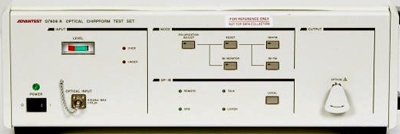
|
|
The Advantest Q7606A Optical Chirpform Test Set is a lightwave modulation test set, used together with a digital sampling oscilloscope, to separately measure and evaluate the chirp (frequency-modulated / FM) and intensity-modulated (IM) components of incident laser light. The Q7606A contains two sets of fiber-type Mach-Zehnder interferometers and their control circuits. The Q7606A can selectively output the sum of, or difference between the frequency-modulated / FM and IM components of the modulated incident light by switching the measurement mode. The sum (IM+FM) and difference (lM-FM) data are processed by the digital sampling oscilloscope and the personal computer to separate the chirp FM and IM components from each other, thus making it possible to evaluate the time-domain charactenstics. Specifications. Wavelength measurement range: 1530 to 1580 nm. Optical input power range: -10 to 10 dBm. Free Spectral Range: 150 GHz ±15 GHz. Demodulation band width (130 MHz as standard, 1 dB down):100 Hz to 50 GHz. Deviation of demodulation frequency: 65 GHz p-p or less. Resolution of demodulation frequency (Depends on the measurement resolution of an external sampling oscilloscope and input optical power.: 20 MHz p-p or less. Optical output power (Output optical power in average. Optical power will be automatically adjusted by the automatic gain adjustment function.): 0 dBm or higher. Built-in optical amplifier with automatic gain adjuster. Input light polarization compensation: Automatically controlled.
|